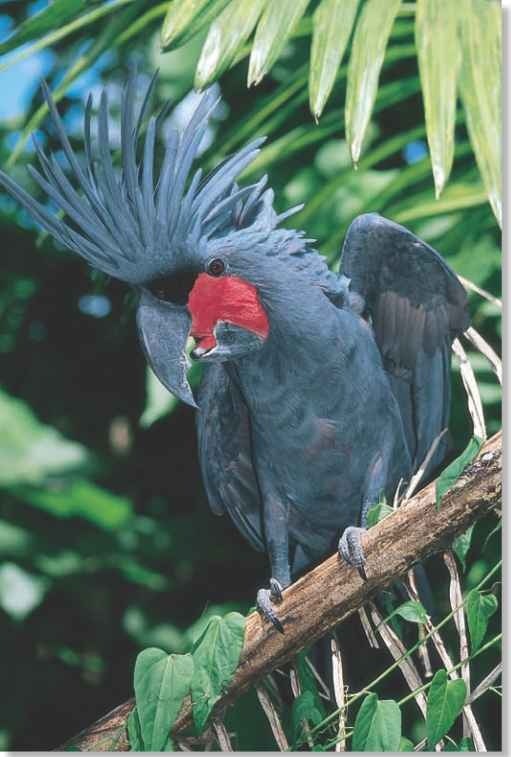ORDER
Psittaciformes
FAMILY
Cacatuidae
GENUS & SPECIES
KEY FEATURES
• Largest of all cockatoos — measures up to 27″ in length
• Deftly cracks open nuts and the hard fruit of its favorite food, Pandanus palm, with its uniquely-shaped bill
• Cannot hiss like other cockatoos, but is adept at mimicking human language
• Captive birds live more than 30 years
WHERE IN THE WORLD?
Found in the tropical rainforest of New Guinea and in north | Australia on the Cape York Peninsula; also on Misool, Yapen, West Papuan and Aru islands
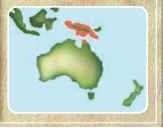
Lifecycle
Unlike other cockatoos, the palm cockatoo does not congregate in large flocks; it roosts alone, feeds alone or in pairs and rarely forms groups of more than seven.
HABITAT
In Australia, the palm cockatoo makes its home in the eucalyptus forests of the Cape York Peninsula and the rainforests of the Aru Islands; in New Guinea, it populates the dense savannah woodlands in the northern and western sections of the island. Palm cockatoos inhabit wetter, warmer climates than most other cockatoo species and usually perch in leafless branches. Mating pairs maintain territories with several good nesting trees, which they check on periodically during the year.
Majestic perch The watchful cockatoo scans the humid rainforest that it calls home.
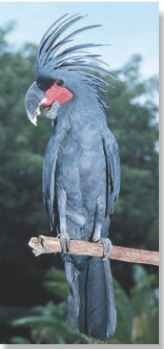
CONSERVATION
The population of palm cockatoos is diminishing. In New Guinea the bird’s rainforest habitat has been reduced due to logging; people also hunt the birds for food and capture them so they can be sold in other countries as pets. In Australia the palm cockatoo is protected and listed in Appendix I of CITES, yet many of these popular birds are smuggled out of the country each year.
BREEDING
Young palm cockatoos demand constant and attentive care, so adults form strong pair bonds and share parenting duties. Since they pair for life and remain close together throughout the year, courtship rituals are kept to a minimum, with only courtship-feeding the rule.Together the male and female regularly inspect theirterritory for potential nesting sites.The ideal home is a hollow spot in a tree, 10-25′ above the ground. Once they choose a site, they’ll use it year after year, constructing a nest by shredding twigs and dropping them into the hollow (left).
Both parents incubate the single egg for about 30 days. Then the chick begins the difficult and exhausting hatching process, which can take 3-4 days; it finally emerges without down. The chick will stay in the nest for between 100-1 10 days, longer than any other parrot species. It will be two more weeks before the young cockatoo is ready to make its first flight.
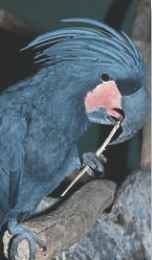
LOG CABIN
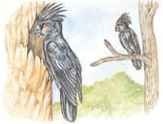
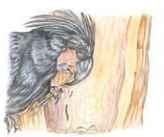
A suitable site…
Pairs mate for life; their first task as a mating pair is to find a safe, hollow tree in which to build their nest.
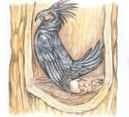
Baby makes three…
After a 30-day incubation, the female usually lays a single egg. Chicks remain in the safety of the nest for up to 110 days.
Making the bed…
The two birds work together to build a nest by gathering sticks and then shredding and dropping them inside to form a platform.
Dual parenting
A young cockatoo is demanding: both parents work to feed and care for their offspring until six weeks after it leaves the nest.

FOOD & FEEDING
The humid rainforests offers the cockatoo an abundance of nuts, fruits, seeds and grubs. The bird shells and eats nuts efficiently: first, it husks the nut, turning it with its tongue while working the shell off with its beak. Then it splits the nut in two, storing the halves in its lower mandible. With a cache stored, the bird can push pieces forward with its tongue, split them on the edge of its lower beak and throw them back with a quick toss of its head, to be swallowed.
Skilled craftsman The cockatoo sharpens its 5U before feeding.
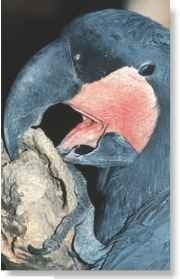
Males sometimes exhibit a curious courtship behavior: they hold small sticks in their claws and drum on a hollow log.
Cockatoos appear to be playful birds. They have been observed flying at one another, trying to knock each other from their perches.
BEHAVIOR
‘aim cockatoos roost separately, but call to each other after sunrise. After a brief foraging trip, a relatively small flock gathers in neutral territory. There they preen, display and interact socially. Long flights are usually necessary between roosting and feeding sites; the group disperses and often meets again at a convenient tree. At sunset, pairs leave the group and return to their own territories. After making a round of the nesting area, the two birds each roost separately. If predators or other birds intrude, a palm cockatoo stamps its feet and its facial patches blush a deep crimson.
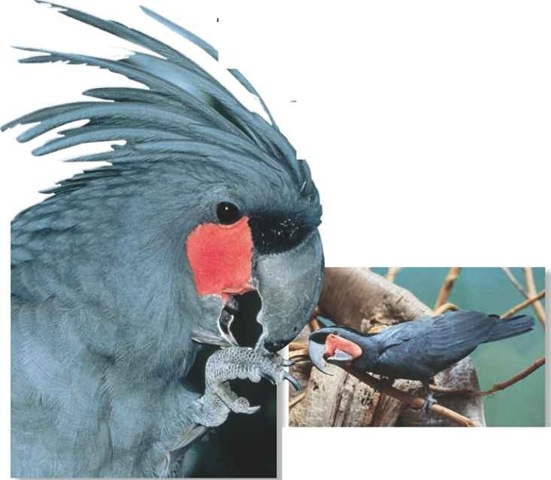
Palm pedicure A cockatoo uses its bill to clean its foot and claws.
A Low now
A cockatoo bends over during a social encounter.
Profile
Palm Cockatoo
With its broad tail and impressive, fanlike head crest, the palm cockatoo appears quite large, but it’s in fact relatively lightweight.
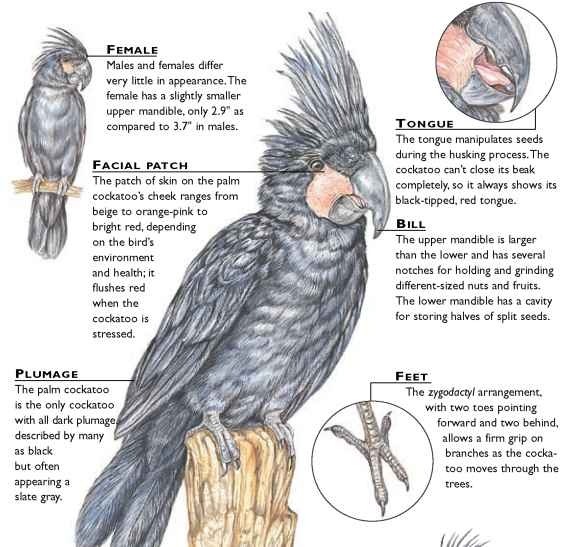
CREATURE COMPARISONS
Unlike the palm cockatoo, the red-tailed black cockatoo (Calyptorhynchus banksii) has adapted to the drier conditions in the woodlands and shrublands of northern Australia and the open forests of the southeastern part of the continent. Measuring about 25″ in length, the red-tailed black cockatoo is similar in size to the palm cockatoo. It lacks the palm cockatoo’s head crest, but the male red-tailed cockatoo distinguishes itself with splashy red panels in its tail, hence its name; the female has orange and yellow spots and bars. Red-tailed
black cockatoo
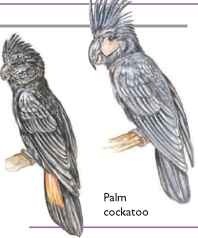
| VITAL STATISTICS | |
| Weight | Male 1-2.5 lbs.; female 1-2 lbs. |
| Length | 19-27″ |
| Sexual Maturity | Unknown |
| Breeding – Season | October- ‘ December |
| Number of Eggs | 1-2 |
| Incubation Period | 30 days |
| Fledging Period | Up to 135 days |
| Breeding Interval | “1′ year |
| Typical Diet | Fruits, berries, seeds and grubs |
| Lifespan | Over 30 years, in captivity; unknown in the wild |
RELATED SPECIES
• The palm cockatoo, often called the great black cockatoo, is the only species in its genus, Probosciger, but is 1 of 6 species of black cockatoo in 2 genera, including the glossy black cockatoo, Calyptorhynchus lathami. These birds join 14 species of white/gray cockatoo and 1 species of cockatiel in the family Cacatuidae. The cockatiel is the smallest in the family, weighing only 3 oz.’
